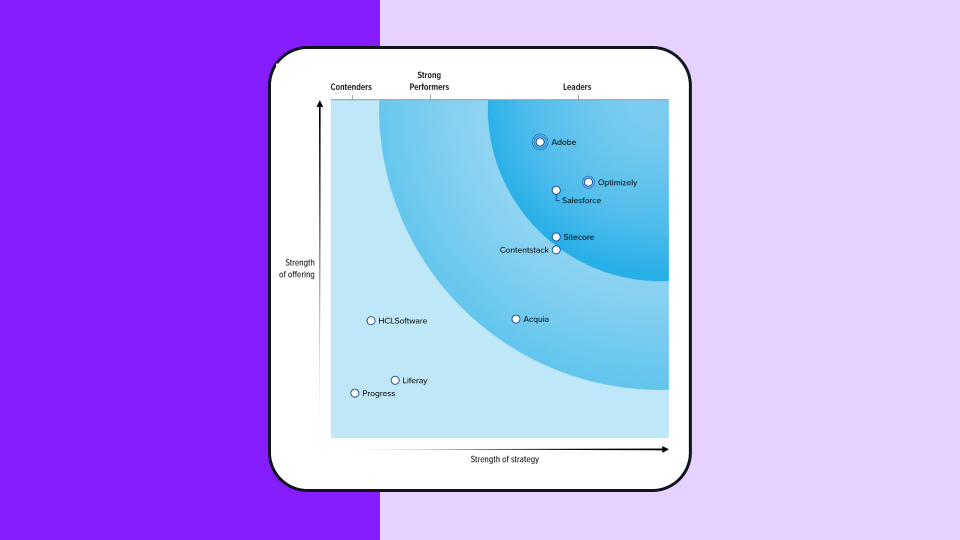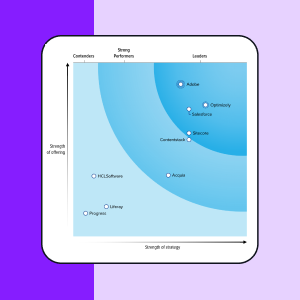Bucket testing
Vad är bucket testing?
Bucket testing (ibland kallat A/B-testning eller split testing) är en term som används för att beskriva metoden att testa två versioner av en webbplats mot varandra för att se vilken som presterar bättre på angivna nyckeltal (t.ex. klick, ladda ner eller köp). Det används för datadrivet beslutsfattande och för att förbättra användarupplevelsen i digitala produkter.
Vid bucket testing finns det minst två variationer i varje test: Variation A (vanligtvis kontrollversionen eller den befintliga versionen) och Variation B (den nya versionen). Mätvärden från varje sidvariation mäts och besökare placeras slumpmässigt i respektive "bucket" där data kan registreras och analyseras för att avgöra vilken som presterar bäst.
Varför är bucket testing viktigt?
Företag som marknadsför och säljer produkter eller tjänster online förlitar sig på bucket testing för att
- Maximera intäkterna genom optimering av webbplatser och landningssidor för konvertering
- Fatta välgrundade, datadrivna beslut om design och innehåll
- Kontinuerligt förbättra klickfrekvensen och användarupplevelsen
- Eliminera gissningar och subjektiva åsikter när användargränssnitt utformas
Statistisk signifikans är också väldigt viktigt för bucket testing. Det avser sannolikheten för att skillnaden i prestanda mellan variationer inte beror på slumpmässiga omständigheter.
Vanligtvis anses en konfidensnivå på 95% eller högre vara statistiskt signifikans. Statistisk analys säkerställer testresultatens tillförlitlighet så att du kan fatta välgrundade beslut för din målgruppsinriktning.
Så här fungerar det: Ett exempel
Låt oss titta på ett hypotetiskt exempel. Varje bucket testing börjar med en hypotes om att en annan version av en landningssida kommer att prestera bättre än kontrollen. Säg att du har en befintlig landningssida för en gratis e-bok om näringslära, "Eat Raw Foods and Live Longer".
Knappen längst ner på landningssidans registreringsformulär säger "Skicka", men du antar att om du ändrar texten till "Få din gratiskopia" kommer det att leda till fler konverteringar av formuläret. Den befintliga sidan med knappen "Skicka" är kontrollen eller variation A. Sidan med "Få din gratiskopia" på knappen är variation B. Det viktigaste måttet du kommer att mäta är andelen besökare som fyller i formuläret.
Eftersom du har en annonskampanj som driver flera tusen besökare per dag till din landningssida tar det bara några dagar att få resultaten från ditt bucket testing. Det visar sig att "Get Your Free Copy" har en betydligt högre klickfrekvens än "Submit", men att andelen som fyller i formuläret är i princip densamma. Eftersom slutförandegraden för formuläret är det viktigaste måttet bestämmer du dig för att prova något annat.
Bucket testing vs. andra testmetoder
Även om bucket testing är kraftfullt är det inte den enda typen av testmetod som finns tillgänglig:
- Multivariat testning: Få funktionalitet för att testa flera variabler samtidigt, användbart för komplexa sidor men kräver mer trafik.
- Flerarmad bandit-testning: Dynamisk allokering av trafik till bättre presterande varianter, användbart för kortsiktiga kampanjer.
Fördelen med bucket testing är dess enkelhet och tydliga resultat, vilket gör den idealisk för att testa specifika hypoteser.
Processen för bucket testing och konverteringsoptimering
Användbarhetstestet av bucket testing spelar en stor roll i konverteringsoptimering. När du väl har förstått användarnas beteende kan du köra ett bucket testing och testa alla hypoteser som kan förbättra användarengagemanget och sidans konverteringar. Du kan fortsätta att prova knapptext med högre konverteringsgrad för Eat Raw Foods and Live Longer eller så kan du fortsätta att testa andra hypoteser, till exempel djärvare rubriker, mer färgstarka bilder eller pilar som pekar mot registreringsknappen som får fler att konvertera.
Företag spenderar miljontals dollar för att driva trafik till landningssidor och webbplatser som marknadsför deras produkt eller tjänst. Med enkla variationer av sidtexter, bilder och layouter kan du genomföra en serie bucket testing för att samla in data och iterera mot din mest högpresterande version av sidan.
Du skapar helt enkelt variationer av sidan, ändrar ett element i taget och mäter nyckeltal, och samlar sedan in resultaten tills du når statistiskt signifikanta resultat för varje experiment.
Bucket testing kan ha en betydande inverkan på konverteringar per sida, vilket resulterar i intäktsökningar på dina mest besökta sidor.
Bucket testing kan också bidra till att eliminera subjektiva åsikter som avgörande faktorer för en sidas design eller layout. Författaren till Eat Raw Foods and Live Longer kanske tror att hennes foto kommer att driva mer kundefterfrågan - eller så insisterar hon på en regnbågspalett av färger.
Med bucket testing finns det inget behov av debatt om vilken design eller vilka sidelement som fungerar bäst för att konvertera en kund. De kvantitativa uppgifterna kommer att tala för sig själva och driva beslutet åt dig.
Tester bör prioriteras för att köras på dina mest trafikerade sidor, eftersom du kan behöva hundratals eller tusentals besökare på varje variation för att samla in statistiskt signifikanta data. Ju mer trafik en sida får, desto snabbare kommer du att kunna utse en vinnare.
Vanliga sidelement att testa:
- Rubriker och underrubriker: variera längd, storlek, typsnitt och specifika ordkombinationer
- Bilder: variera antalet bilder, placering, typ av bilder (fotografi vs. illustration) och bildernas ämne
- Text: Varierande antal ord, stil, typsnitt, storlek och placering
- Call to action (CTA) -knappar: olika vanligaknappar som "Köp nu", "Registrera dig", "Skicka in", "Kom igång" eller "Prenumerera" och olika storlekar, färger och sidplacering
- Logotyper från kunder eller webbplatser från tredje part: skapar trovärdighet och förmedlar pålitlighet (kan inkludera logotyper från Better Business Bureau, TRUSTe eller VeriSign samt kundlogotyper)
Begränsningar och bästa praxis för bucket testing
Här är några av begränsningarna med bucket testing:
- Kräver betydande trafik för att ge resultat
- Den här metoden kanske inte är lämplig för att testa radikala förändringar
- Resultaten kan påverkas av externa faktorer (säsongsvariationer, kampanjer etc.)
- Att genomföra flera tester samtidigt kan störa varandra
Det är därför du måste följa några av nedanstående bästa praxis för att säkerställa effektivitet.
- Ha en tydlig hypotes innan du påbörjar testet
- Testa ett element i taget för att få tydliga resultat
- Se till att urvalet är tillräckligt stort för statistisk signifikans
- Kör testerna under en lämplig tidsperiod (vanligtvis minst en vecka)
- Var medveten om externa faktorer som kan påverka resultaten negativt (t.ex. helgdagar, marknadsföringskampanjer)
- Prioritera alltid testning på sidor med hög trafik för snabbare resultat
Kom igång med bucket testing
Bucket testing är ett kraftfullt verktyg för att optimera digitala upplevelser och driva affärstillväxt. Genom att systematiskt testa hypoteser och mäta resultat kan du förbättra användarupplevelsen och öka konverteringen.
Med Optimizely's A/B-testning kan du köra bucket testing på alla dina webbsidor och landningssidor utan att behöva förlita dig på IT-support. Du kan ställa in tester inom några minuter, optimera alla dina sidor och börja fatta mer välgrundade beslut om ditt företag.
Börja testa med Optimizely Web Experimentation idag!
![]()

